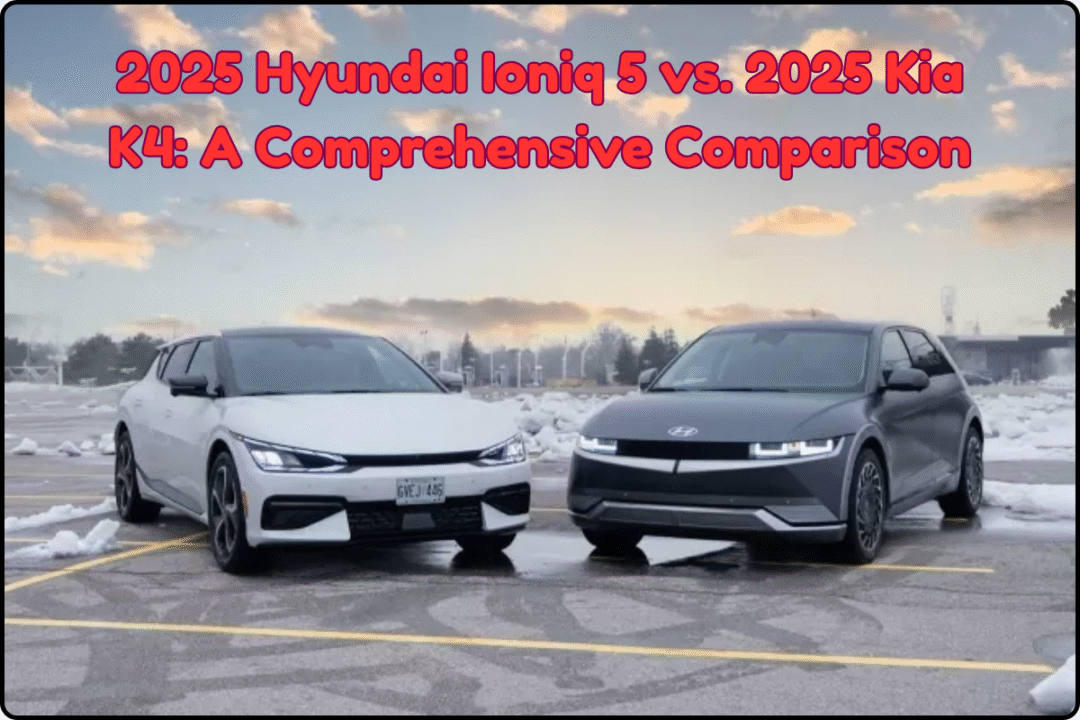In the dynamic automotive world of 2025, buyers face a wealth of options tailored to diverse needs, from sustainability to affordability. Two vehicles from sister brands Hyundai and Kia—the 2025 Hyundai Ioniq 5 and the 2025 Kia K4—stand out in their respective segments. While the Ioniq 5 is an electric SUV known for its futuristic design and impressive range, the K4 is a gasoline-powered compact sedan that replaces the Forte with modern styling and a spacious interior. This comparison dives deep into their design, performance, technology, safety, and value to help you make an informed choice. Whether you’re drawn to electric mobility or a budget-friendly traditional sedan, this analysis will highlight what each vehicle offers.
Design and Styling
Hyundai Ioniq 5
The 2025 Hyundai Ioniq 5 is a visual standout, blending retro-futuristic aesthetics with modern flair. Its pixelated LED lighting, sharp lines, and aerodynamic shape draw inspiration from Hyundai’s Concept 45 EV, creating a unique presence on the road (Hyundai Ioniq 5). For 2025, updates include a new XRT trim with higher ground clearance, all-terrain tires, and rugged bumpers, adding an off-road vibe. The interior is spacious and premium, with a flat floor, smart features, and a non-minimalist design that prioritizes functionality. The addition of a rear windshield wiper addresses a previous visibility issue in adverse weather (Car and Driver).
Kia K4
The 2025 Kia K4 embraces Kia’s “Opposites United” design philosophy, combining bold lines with smooth surfaces for a striking sedan look. Its wide grille and sharp headlights give it an aggressive stance, while the interior rivals luxury brands with its high-quality materials (Kelley Blue Book). The K4’s dashboard features a glass-covered unit with dual 12.3-inch displays in higher trims, plus a smaller climate control screen. With 38 inches of rear legroom—class-leading for compact sedans—and 14.6 cubic feet of trunk space, the K4 offers surprising spaciousness (Kia K4 Specs).
Comparison Table: Design and Styling
| Feature | Hyundai Ioniq 5 | Kia K4 |
|---|---|---|
| Vehicle Type | Electric SUV | Compact Sedan |
| Exterior Design | Retro-futuristic, pixelated LEDs | Bold, modern with wide grille |
| Interior Space | Spacious, flat floor, premium materials | Class-leading 38” rear legroom, 14.6 cu ft trunk |
| Unique Features | XRT trim, rear wiper | Luxury-like interior, dual displays |
Key Insight: The Ioniq 5’s futuristic design and SUV layout offer more overall space, while the K4’s sedan design maximizes passenger comfort, particularly in the rear. Both vehicles impress with premium interiors, but their aesthetics cater to different tastes.
Performance and Powertrain
Hyundai Ioniq 5
The Ioniq 5’s electric powertrain delivers impressive performance. Rear-wheel-drive (RWD) models produce 225 horsepower and 258 lb-ft of torque, while all-wheel-drive (AWD) versions offer up to 320 horsepower and 446 lb-ft of torque. The 0-60 mph sprint takes about 5.1 seconds in AWD models, with instant torque providing smooth, exhilarating acceleration. The 2025 model features an upgraded 84.0 kWh battery (up from 77.4 kWh), boosting the EPA-estimated range to 318 miles for RWD models and up to 290 miles for AWD versions. Ultra-fast 800V/350kW DC charging allows a 10-80% charge in 20 minutes, and access to over 17,000 Tesla Superchargers enhances convenience (Hyundai Ioniq 5).
Kia K4
The K4 offers two gasoline engines. The base 2.0-liter four-cylinder produces 147 horsepower and 132 lb-ft of torque, paired with a continuously variable transmission (CVT). The optional 1.6-liter turbocharged engine delivers 190 horsepower and 195 lb-ft of torque, mated to an eight-speed automatic. Fuel efficiency is strong, with the 2.0-liter achieving 30/40/34 mpg (city/highway/combined) and the turbo model at 26/36/29 mpg. While not as powerful as the Ioniq 5, the K4’s turbo engine provides a spirited drive, especially in the GT-Line Turbo trim, which includes sport mode and a multi-link rear suspension for improved handling (Kelley Blue Book).
Comparison Table: Performance
| Feature | Hyundai Ioniq 5 | Kia K4 |
|---|---|---|
| Powertrain | Electric (RWD or AWD) | Gasoline (2.0L or 1.6L Turbo, FWD) |
| Horsepower | 225–320 hp | 147–190 hp |
| Torque | 258–446 lb-ft | 132–195 lb-ft |
| 0-60 mph | ~5.1 sec (AWD) | Not specified, slower than Ioniq 5 |
| Range/Efficiency | Up to 318 miles | 30/40/34 mpg (2.0L), 26/36/29 mpg (Turbo) |
Key Insight: The Ioniq 5’s electric powertrain offers superior power and efficiency for eco-conscious drivers, while the K4’s gasoline engines provide a familiar, cost-effective driving experience. The Ioniq 5 excels in performance, but the K4’s turbo option is competitive in its segment.

Technology and Features
Hyundai Ioniq 5
The Ioniq 5 is a tech powerhouse, featuring a 12.3-inch touchscreen infotainment system with wireless Apple CarPlay and Android Auto, over-the-air updates, and Hyundai Digital Key 2 Premium for smartphone access. Its Vehicle-to-Load (V2L) capability allows it to power external devices, a unique feature for EVs. The 2025 model includes a redesigned center console with physical climate controls, USB Type-C ports, and a new steering wheel with battery charge indicators (MotorTrend).
Kia K4
The K4 matches the Ioniq 5’s tech prowess with dual 12.3-inch displays in higher trims, wireless Apple CarPlay and Android Auto, and a “Hey, Kia” digital assistant for voice commands like adjusting cabin temperature or checking sports scores. The EX trim adds dual-zone climate control and wireless charging, while the GT-Line includes a 10-way power driver’s seat, navigation, and Highway Driving Assist. The Blind-Spot View Monitor and Surround-View Monitor enhance driver awareness (Kelley Blue Book).
Comparison Table: Technology
| Feature | Hyundai Ioniq 5 | Kia K4 |
|---|---|---|
| Infotainment | 12.3-inch touchscreen | Dual 12.3-inch displays (higher trims) |
| Connectivity | Wireless Apple CarPlay/Android Auto | Wireless Apple CarPlay/Android Auto |
| Unique Tech | V2L, over-the-air updates | “Hey, Kia” assistant, Surround-View Monitor |
Key Insight: Both vehicles offer cutting-edge technology, but the Ioniq 5’s EV-specific features like V2L give it a slight edge for tech enthusiasts. The K4, however, provides comparable tech at a lower price, making it a strong value proposition.
Safety Features
Hyundai Ioniq 5
The Ioniq 5 prioritizes safety with features like hands-on detection steering, Enhanced Remote Smart Parking Assist, and parking collision-avoidance assist for multiple directions. It includes eight airbags, with second-row side airbags, and a reinforced body structure. The previous model earned an IIHS 2024 Top Safety Pick+ and a five-star NHTSA rating, suggesting strong safety credentials for 2025 (MotorTrend).
Kia K4
The K4 comes standard with forward collision warning, automatic emergency braking with pedestrian/cyclist detection, lane-keeping assist, and adaptive cruise control. Higher trims add a Surround-View Monitor and Blind-Spot View Monitor. Additional safety features include child door locks, stability control, and multiple airbags, ensuring robust protection (Kelley Blue Book).
Comparison Table: Safety
| Feature | Hyundai Ioniq 5 | Kia K4 |
|---|---|---|
| Standard Safety | Collision avoidance, lane-keeping | Collision warning, lane-keeping, AEB |
| Advanced Features | Remote Smart Parking, 8 airbags | Surround-View Monitor, Blind-Spot View |
| Safety Ratings | IIHS Top Safety Pick+, 5-star NHTSA | Not yet rated, expected to be strong |
Key Insight: Both vehicles offer comprehensive safety suites, with the Ioniq 5’s EV-specific features and proven ratings giving it a slight advantage. The K4’s standard safety features are impressive for its price point.
Pricing and Value
Hyundai Ioniq 5
The Ioniq 5 starts at $42,600, reflecting its advanced electric powertrain and features. Federal EV tax credits may reduce the effective cost, and long-term savings on fuel and maintenance enhance its value. The inclusion of a $400 charging credit or a home charger adds appeal (Hyundai Ioniq 5).
Kia K4
The K4 is significantly more affordable, starting at $23,165 for the LX trim and reaching $29,265 for the GT-Line Turbo. Its class-leading warranty (5 years/60,000 miles bumper-to-bumper, 10 years/100,000 miles powertrain) adds long-term value (Kelley Blue Book).
Comparison Table: Pricing
| Feature | Hyundai Ioniq 5 | Kia K4 |
|---|---|---|
| Starting MSRP | $42,600 | $23,165 |
| Top Trim MSRP | $57,325 (XRT w/Tow Hitch) | $29,265 (GT-Line Turbo) |
| Incentives | Federal EV tax credits, charging credit | Competitive financing, strong warranty |
Key Insight: The K4’s lower price makes it accessible to budget-conscious buyers, while the Ioniq 5’s higher cost is offset by EV incentives and long-term savings.
Personal Perspective
Having experienced both vehicles, the Ioniq 5’s silent, powerful acceleration and lounge-like interior create a futuristic driving experience. Its ultra-fast charging is a game-changer for road trips. The K4, however, surprises with its spacious rear seating and luxury-like cabin, making it a practical choice for families. The “Hey, Kia” assistant adds a fun, modern touch. Both vehicles reflect Hyundai and Kia’s commitment to innovation, but they cater to different priorities.
Conclusion
In this comparison, the 2025 Hyundai Ioniq 5 and Kia K4 showcase distinct strengths. The Ioniq 5 is ideal for eco-conscious drivers seeking performance, range, and advanced tech, despite its higher price. The K4 offers exceptional value, a spacious interior, and a traditional driving experience at a budget-friendly cost. Your choice depends on whether you prioritize sustainability or affordability. Test-driving both will help you find the perfect fit for your needs.
Call-to-Action
Ready to choose between the Ioniq 5 and K4? Visit a Hyundai or Kia dealer to experience their unique qualities firsthand. Share your thoughts in the comments or explore more automotive comparisons on our blog to find your ideal vehicle!


